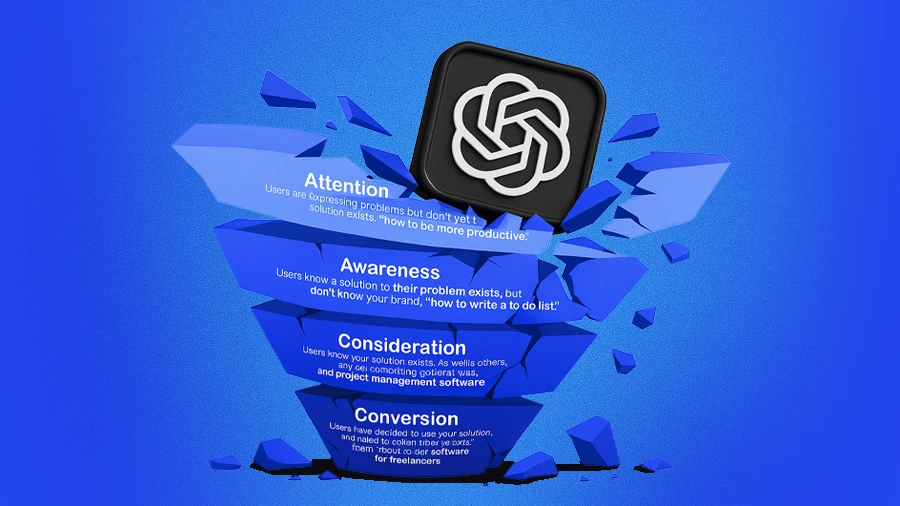


AI-powered research creates a "pre-informed" customer, collapsing the traditional marketing funnel and forcing brands to adapt to a new, faster path to purchase.
Josh Grant, VP of Growth at Webflow, argues that "intent velocity" is the new key metric, requiring companies to convert highly-informed users at maximum speed.
Grant explains why brands need to invest in Answer Engine Optimization (AEO) to create conclusive content that influences decisions before a customer ever visits a brand's website.
He also highlights the need to build AI-native teams to automate internal processes, which in turn unlocks growth.
For decades, the B2B path to purchase was a predictable journey from awareness to consideration to conversion, guided largely by a brand’s own content. That journey now has a new starting line where AI-powered tools like ChatGPT have become the de facto research assistants for millions. That means customers are doing their homework long before they ever visit a company’s website.
This shift has created a formidable type of prospect. They join sales meetings with pre-researched answers and are ready to buy. The game isn't won by high-volume lead generation anymore. It’s about the speed at which you can convert a highly-informed user from their first touch to a final sale. That's called intent velocity, and it's the new north star metric for growth teams.
We spoke with Josh Grant, VP of Growth at website builder Webflow and former Head of Growth at fintech leader Affirm, who argues that winning in the AI era requires a new playbook designed for speed, clarity, and discovery.
The pre-informed customer: The new approach to pre-sale research is forcing a fundamental rethink of how brands get discovered, how they close the deal, and how they measure success. "Customers are using tools like ChatGPT to do their research, meaning by the time they get to your landing page or your homepage, they're already informed," Grant stated. "Theoretically, this shortens the path to purchase, but you also have to think about how you're showing up in the outputs of LLMs."
Designing for velocity: If a customer arrives with their mind already made up, the purpose of a landing page fundamentally changes. The priority shifts from education to execution. For Grant, this means the entire conversion path must be optimized for speed. "Conversion rate optimization is where you need to index," he said. "That means really clear CTAs designed for a frictionless user experience. It's all about velocity."
If the decision is being made before the visit, how do you influence it? The answer lies in mastering Answer Engine Optimization (AEO), a discipline focused on ensuring a brand's content isn't just found by AI, but used to construct its answers. Compared with SEO, AEO prioritizes completeness over keywords. According to recent data on top-cited source for AI, LLMs place immense trust in community-driven and review-based platforms. "Wikipedia still actually dominates," Grant noted. "Reddit and G2 are also quite strong for LLMs."
Winning the answer: To win the "answer," brands must rethink their content strategy, moving beyond simple keywords to provide comprehensive, definitive responses. "You need to structure content in a way that actually resolves the entire answer," he explained. "LLMs use that context for the final output it provides to the end user." He pointed to "frequently asked question pages" as more important than ever, allowing brands to go deep on a topic and provide the rich, self-contained responses that LLMs crave.
A clarity check: Far from being a compromise, AEO, in Grant's view, serves as a powerful quality control mechanism for all content. "Writing for AI and writing for humans are more similar than you'd think," he said. "Optimizing for AEO gives us this critical lens where we need to make sure that there's no open-endedness or ambiguity. It's like a gut check to make your content as effective as possible, whether it is for human eyes or an LLM."
Executing this external strategy requires a new internal engine. Grant championed building AI-native teams where automation isn't just a project, but a core competency that drives both efficiency and growth. At Webflow, this is already in practice with his team using AI for "automated content refreshes" and "webinar-to-evergreen-content translation." By using tools to update content in the company’s brand voice with a human-in-the-loop for authenticity, they have dramatically increased their velocity. "Subsequently, we're seeing increased traffic to pages we've optimized," he said. "We're seeing quantifiable results from that investment."
Unlocking growth: Grant viewed the internal efficiency at Webflow as a direct lever for external growth, freeing up human capital for higher-value strategic work. "I have AI agents set up to scrape week-over-week Tableau reports and give me the business analysis of it," he said. "Now an analyst doesn't have to spend their time there. It unlocks so much efficiency and growth."
The connection between internal AI-driven efficiency and external AEO strategies is crucial, but Grant cautions that this new landscape is anything but static. The rapid evolution of AI models means that what works today may not work tomorrow. This constant state of flux demands a mindset of continuous learning and adaptation. His final piece of advice is a warning against complacency and a call for relentless adaptation. The biggest mistake is thinking you have it all figured out. "No one has this down to a science yet," Grant said. "It is evolving, truly, every single day. The winning teams will be the ones that embrace this chaos as an opportunity."